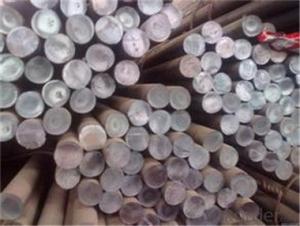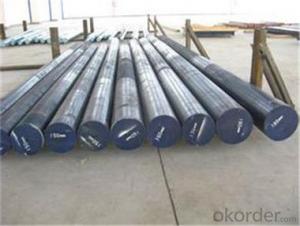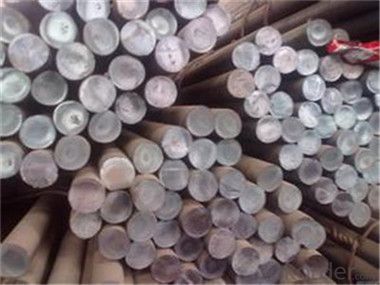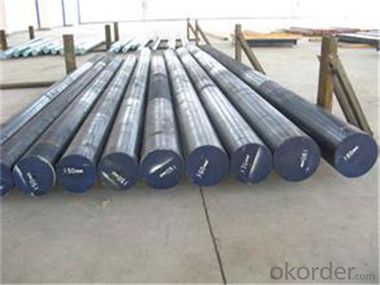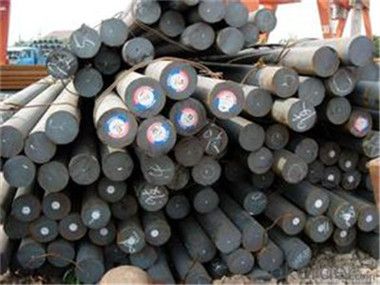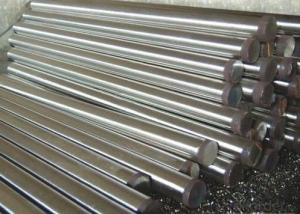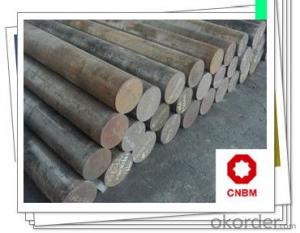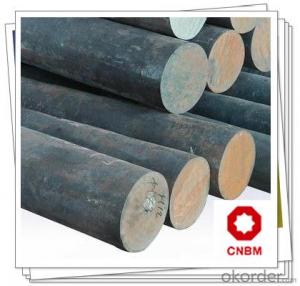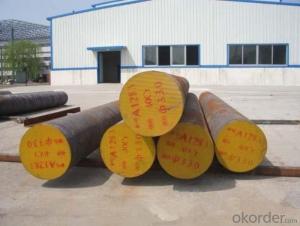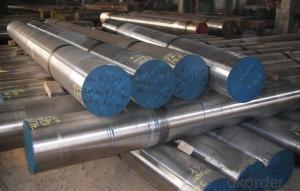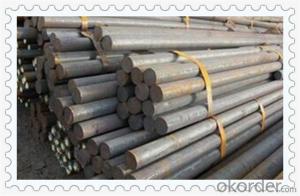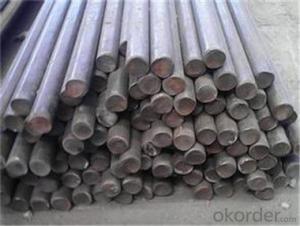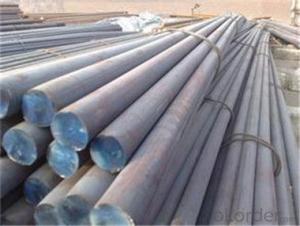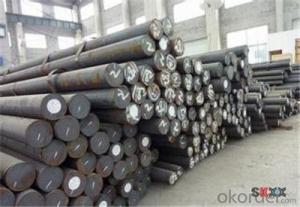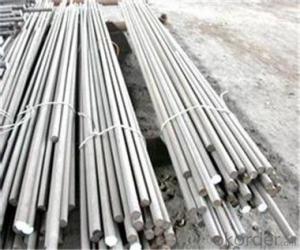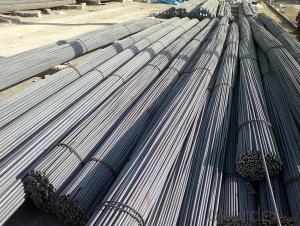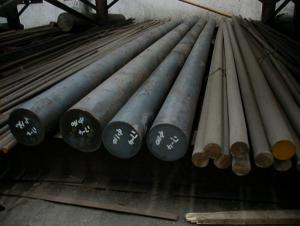Steel Round Bar Reliable Manufacturer with High Quality
- Loading Port:
- Tianjin
- Payment Terms:
- TT OR LC
- Min Order Qty:
- 55 m.t.
- Supply Capability:
- 2000000 m.t./month
OKorder Service Pledge
OKorder Financial Service
You Might Also Like
Description of steel round bar:
1.Diameter 80 to 800 mm
2.Black or Bright surface
3.Annealed or Quenched and tempered provided
4.Cutting service provide
This steel has good workability,processing deformation is small, anti fatigue performance is quite good, belongs to medium quenching steel,4140 after heat treatment, it has good strength and good comprehensive mechanical properties.The process is good.
Festures of steel round bar:
4340 Forged Round Steel Bar
1.Dia 80-800mm Length:2000-13000mm or as required
2.Technique:Forged
3.Delivery Time:45 days
Specifications of steel round bar:
1. Standards: AISI 4340 8620 8640 4320 , JIS SNCM8 GB:40CrNiMoA
2. Specification: Dia: 80~450mm Length:2000-13000mm or as required
3. Process: EAF+LF+VD ( necessary) UT+ Peeled +Turned + Heat Treatment (optional)
Images of coffee machine:
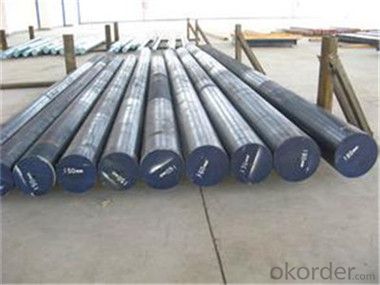
FAQ:
1. What is your package?
Packing situation: standard seaworthy packing or as customer required.
2. How long is the lead time?
Delivery time: 45 days after order confirmed.
3. What payment term do you accept?
Payment: T/T or L/C at sight.
- Q: Can steel round bars be forged?
- Indeed, it is possible to forge steel round bars. The act of forging entails subjecting the steel to elevated temperatures and subsequently molding it by exerting pressure using either a forging hammer or press. In the realm of forging procedures, steel round bars frequently find application in fabricating diverse forms and items, including tools, automotive components, and machinery parts. The intense heat generated during the forging process endows the steel with enhanced malleability, rendering it more pliable and amenable to shaping, thereby yielding a final product that is robust and long-lasting.
- Q: What is the maximum weight capacity of a steel round bar?
- The maximum weight a steel round bar can hold depends on several factors, including its diameter, length, grade, and type of steel. Steel round bars are available in various sizes and grades, each with its own load-bearing capacity. To determine the maximum weight a steel round bar can handle, you need to calculate its cross-sectional area using the formula: Area = π * (diameter/2)^2. Here, π represents a mathematical constant that is approximately equal to 3.14159. Once you have the cross-sectional area, you can estimate the weight of the bar by multiplying it with the density of the specific steel grade. The density of steel varies based on the grade, but as a general approximation, it is around 7850 kilograms per cubic meter (or 0.00785 grams per millimeter cubed). However, it's important to remember that weight capacity alone may not be the only factor to consider for the safe use of a steel round bar. Other factors like load distribution, applied forces, and the structural integrity of the bar are equally important to ensure safe operation. For accurate weight capacity information for a specific steel round bar, it is recommended to refer to the manufacturer's specifications or consult a qualified engineer or professional who can provide precise calculations based on the specific requirements and characteristics of the steel round bar in question.
- Q: What are the advantages of using steel round bars?
- There are several advantages to using steel round bars. Firstly, steel round bars have high strength and durability, making them suitable for various applications that require structural integrity and resistance to wear and tear. Secondly, steel round bars offer excellent machinability, allowing for easy shaping and customization according to specific project requirements. Additionally, steel round bars have a high load-bearing capacity, making them an ideal choice for heavy-duty applications such as construction and manufacturing. Lastly, steel round bars have good corrosion resistance, making them suitable for outdoor and marine environments where exposure to moisture and harsh conditions is common.
- Q: Can steel round bars be used in the production of fasteners?
- Indeed, the utilization of steel round bars is feasible when fabricating fasteners. In the realm of fastener production, steel round bars serve as a prevalent raw material, employed in the manufacturing of an array of fasteners such as bolts, screws, nuts, and studs. The circular nature of steel bars facilitates the machining and forming procedures essential for the creation of threaded or non-threaded fasteners. Steel is a favored choice for fasteners due to its robustness, longevity, and resistance to corrosion. Furthermore, steel round bars can be readily subjected to heat treatment, enhancing their mechanical attributes and rendering them suitable for a vast array of fastening applications across multiple industries.
- Q: Can steel round bars be used in the manufacturing of tools?
- Indeed, tools can be manufactured using steel round bars. The utilization of steel round bars in tool manufacturing is prevalent owing to their exceptional strength, endurance, and adaptability. These bars furnish the essential structural stability and resilience essential for a variety of tools, including wrenches, hammers, chisels, and screwdrivers. The circular form of the bar facilitates effortless machining and formation into diverse tool constituents. Moreover, steel round bars can undergo heat treatment to augment their hardness and resistance to wear, rendering them suitable for demanding and high-achieving tool applications.
- Q: What are the different types of steel round bar surface defects?
- There are several types of steel round bar surface defects, including pits, roll marks, scratches, cracks, scale, and decarburization.
- Q: Are steel round bars magnetic?
- Indeed, steel round bars have the potential to possess magnetic characteristics. The magnetism of steel is contingent on its composition and processing methods. The predominant steel alloys utilized, such as carbon steel or stainless steel, prominently feature iron as their primary constituent. Iron is recognized as a ferromagnetic substance, signifying its susceptibility to magnetization. Thus, steel round bars constructed from these alloys will inevitably display magnetic attributes. However, it is crucial to acknowledge that the strength of the magnetism can fluctuate depending on the precise composition of the steel. Certain stainless steel alloys, for instance, possess a lower magnetic permeability and may consequently manifest diminished magnetic traits in comparison to carbon steel.
- Q: How do you calculate the strength of a steel round bar?
- To calculate the strength of a steel round bar, several factors need to be considered. The primary factor is the material's yield strength, which represents the stress level at which the steel begins to deform permanently. This value is typically provided by the manufacturer or can be found in engineering handbooks. Next, the cross-sectional area of the round bar needs to be determined. This can be done by measuring the diameter of the bar and using it to calculate the area using the formula A = πr^2, where A is the cross-sectional area and r is the radius. Once the cross-sectional area is known, the ultimate tensile strength (UTS) can be calculated using the formula UTS = Yield Strength / Safety Factor. The safety factor is a numerical value that accounts for uncertainties and potential variations in the material's strength. It is typically specified by the design requirements or industry standards. Finally, the maximum load that the steel round bar can withstand before failure can be determined by multiplying the ultimate tensile strength by the cross-sectional area. This value represents the strength of the round bar and can be used to assess its suitability for a particular application. It is important to note that other factors such as the bar's length, shape, and any additional treatments or modifications can also affect its strength. Therefore, consulting with a structural engineer or referring to relevant design codes and standards is recommended to ensure accurate calculations and safe application of steel round bars.
- Q: What is the yield strength to tensile strength ratio of a steel round bar?
- The yield strength to tensile strength ratio of a steel round bar, also known as the yield-to-tensile ratio, is an important mechanical property that indicates the material's ability to withstand deformation before it fails under tension. This ratio is typically used to evaluate the ductility and brittleness of a steel bar. In general, the yield strength is the stress at which a material begins to exhibit plastic deformation, while the tensile strength is the maximum stress the material can withstand before it fractures. The yield strength to tensile strength ratio is calculated by dividing the yield strength by the tensile strength. The yield-to-tensile ratio varies depending on the specific grade and composition of the steel being used. However, for most common structural steels, the yield-to-tensile ratio typically falls within the range of 0.6 to 0.8. This means that the yield strength is generally around 60% to 80% of the ultimate tensile strength. A higher yield-to-tensile ratio indicates a more ductile and less brittle steel, as it suggests that the material can undergo substantial plastic deformation before ultimate failure. On the other hand, a lower yield-to-tensile ratio indicates a more brittle steel, which is prone to fracture at lower levels of deformation. It is important to note that the yield-to-tensile ratio is just one of many factors to consider when evaluating the mechanical properties of a steel round bar. Other factors such as hardness, toughness, and elongation also play significant roles in determining the overall performance and suitability of the steel for a particular application.
- Q: Can steel round bars be used for making staircases?
- Yes, steel round bars can be used for making staircases. They provide durability, strength, and a modern aesthetic appeal to the staircase design.
Send your message to us
Steel Round Bar Reliable Manufacturer with High Quality
- Loading Port:
- Tianjin
- Payment Terms:
- TT OR LC
- Min Order Qty:
- 55 m.t.
- Supply Capability:
- 2000000 m.t./month
OKorder Service Pledge
OKorder Financial Service
Similar products
Hot products
Hot Searches
Related keywords
